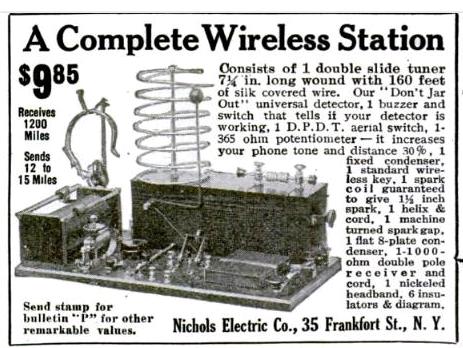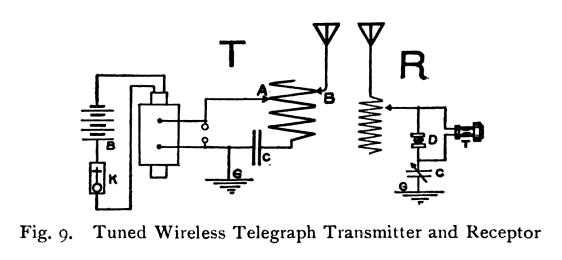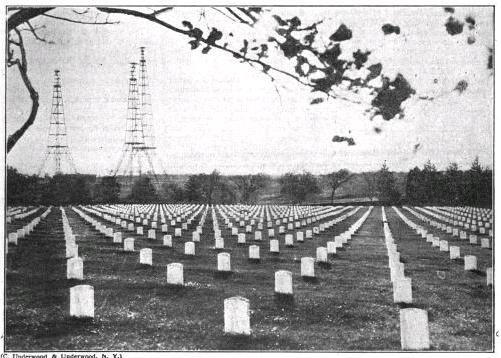 The April 1914 edition of Popular Mechanics includes this Complete Wireless Station for $9.85 from the Nichols Electric Company of 35 Frankfort Street, New York. That address had housed the “Clean and Ready Company” in 1893. It now appears to be part of the campus of Pace University, next to the Manhattan entrance to the Brooklyn Bridge.
The April 1914 edition of Popular Mechanics includes this Complete Wireless Station for $9.85 from the Nichols Electric Company of 35 Frankfort Street, New York. That address had housed the “Clean and Ready Company” in 1893. It now appears to be part of the campus of Pace University, next to the Manhattan entrance to the Brooklyn Bridge.
According to this inflation calculator, the $9.85 cost would be $232.75 in today’s dollars. To look at it another way, that would cost ten silver dollars, or about ten ounces of silver, which would be worth about $200 today. This apparatus seems very similar to one described by Alfred Powell Morgan in his book published in the same year, Wireless Telegraph Construction for Amateurs, with two exceptions: This set doesn’t appear to have the variable condenser shown in Morgan’s schematic, below. On the other hand, this set includes a knife switch in order to use the same antenna for both transmitting and receiving.
The receiver is a simple crystal set, billed as being able to receive 1200 miles. I suspect this figure involves a bit of hyperbole, but I suppose with a good antenna and good conditions, it might be possible to occasionally log stations such as NAA, transmitting time and weather from massive towers overlooking Arlington National Cemetery, shown here in 1922.
The transmitter is billed as being capable of transmitting 12-15 miles. The ad doesn’t mention anything about a license. Licenses had been required since 1912, but it’s quite likely that the owner of this set wouldn’t have bothered. In fact, it’s unlikely that he would have been able to receive a license after explaining to the radio inspector what kind of equipment he was using.
The license requirements are explained in Morgan’s book. Morgan explains:
An amateur may not use transmitting apparatus which is sufficiently powerful to send radio signals across any of the boundaries of the state in which he is located and which can be detected by a sensitive receiving set located just beyond the state boundary, nor can he use apparatus which is powerful enough to interfere with the reception of signals by others from beyond the state boundaries unless he has a license….
In other words if the amateur possesses a receiving outfit only which is in working order or if he has both transmitter and receptor and the.former is not powerful enough to send signals out of the state in which he fives, or to interfere with the reception of messages by another when the messages come from beyond the state boundary a license is unnecessary.
This is of course somewhat unfair for those living near the center of large states for they may operate almost as they please with ordinary instruments with no fear of the signals going beyond the border, while those living within a few miles of another state must secure a license.
Morgan goes on to explain why this set probably wouldn’t qualify for a license:
The law also says that the transmitting wave must be pure, and must be sharply tuned, which means that the wave must be of one length and not, as is very often the case, composed of two or more waves of different lengths.
In order to comply with this restriction, the use of an oscillation helix or loosely coupled helix is necessary. A rotary or quenched gap is also necessary in place of the ordinary spark gap.
The transmitter shown here fails in two regards. First of all, there’s no way of quenching the spark, although I suspect if it was run on batteries, that wouldn’t be much of a problem. The main problem is that the “helix” is basically a tapped autotransformer, and it will probably radiate quite well on at least two wavelengths. In addition, the signal from a transmitter like this is going to have a very wide signal.
I suppose, with a good antenna, this transmitter might be heard 12-15 miles away. But if the owner was more than 15 miles from the state line, it would appear that he could use this without fear of the radio inspector, as long as a licensed station didn’t complain of interference.
By the way, if the name Alfred Powell Morgan rings a bell, you’ll recall why when you visit my Alfred Powell Morgan page.



Pingback: Where To Get Crystal Set Parts | OneTubeRadio.com
Pingback: Minnesota Wireless Association in 1915 | OneTubeRadio.com
Pingback: 1953 Transistor Firsts | OneTubeRadio.com
Pingback: 400 Foot Towers at Great Lakes, Illinois, 1915 | OneTubeRadio.com
Pingback: 1915 Boys’ Life Receiver | OneTubeRadio.com
Pingback: Radio Scouting, 1919 | OneTubeRadio.com
Pingback: Radio Scouting, 1926 | OneTubeRadio.com
Pingback: Highland Park College, Des Moines, IA | OneTubeRadio.com
Pingback: 1922 Crystal Set | OneTubeRadio.com
Pingback: 1919 Portable Crystal Set | OneTubeRadio.com